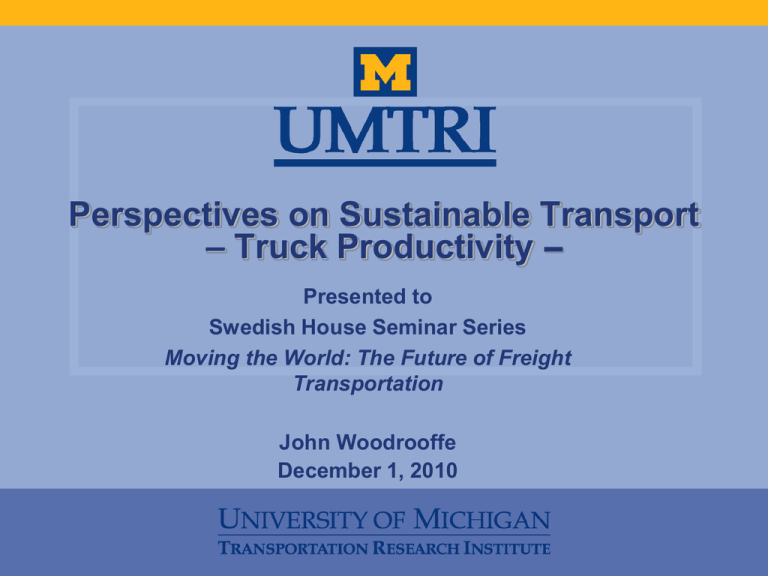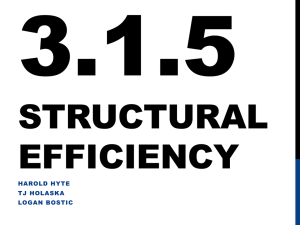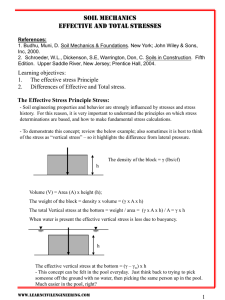UMTRI - Sustainable Transport
advertisement

Perspectives on Sustainable Transport – Truck Productivity – Presented to Swedish House Seminar Series Moving the World: The Future of Freight Transportation John Woodrooffe December 1, 2010 Safety Sustainable Transport Efficiency *Policy* Slide 2 Present time Sustainability Index Contributions to sustainable transport Policy Federal, State, Company, Individual Safety Operational Efficiency Time Slide 3 OECD Truck Benchmarking Study “Moving freight in better trucks” Compared the most common “workhorse” trucks and various high and very capacity vehicles from participating countries in terms of: Road wear performance Impact on road structures Safety performance (with a focus on vehicle design) Productivity (in terms of mass and volume) Environmental impacts (emissions, energy consumption) Slide 4 Defining truck productivity Productivity – how much freight can be hauled in a particular vehicle Note: Truck cargo capacity is limited by weight or volume (depends on freight density) Slide 5 Steady State Energy Balance Total energy used per hour (90 km/h, 44 tonne, level road for one hour) 343 kWh Aerodynamic Losses 53 kWh Engine losses 200 kWh Rolling Resistance 65 kWh Drive train 10 kWh Auxiliary loads 15 kWh Slide 6 Towards sustainable productivity Move as much freight as possible per power unit more safely than the current fleet with less infrastructure consumption Slide 7 Workhorse vehicle Country Steer Drive Tridem GVW Productivity advantage (lbs) (lbs) (lbs) (lbs) South Africa 16,060 39,600 52,800 108,460 39% Mexico 14,300 42,900 49,500 106,700 35% Denmark 17,600 35,200 52,800 105,600 33% Canada 12,100 37,400 52,800 102,300 27% Australia 13,200 37,400 49,500 100,100 23% UK 13,970 35,310 47,500 96,800 17% USA 12,000 34,000 42,000 88,000 ---- Assumed empty weight 35,000 lbs Slide 8 Workhorse vehicle North American context Country GVW Payload (lbs) (lbs) Productivity advantage Mexico 106,700 71,700 35% Canada 102,300 67,300 27% 88,000 53,000 -- USA Assumed empty weight 35,000 lbs Slide 9 Key Message Truck productivity is limited by policy not technology Slide 10 LCV Progressive operations policy can yield substantial societal benefit 53 ft standard trailer 53 ft standard trailer Slide 11 What can advanced LCV policy do (on a per vehicle basis) System category Benefit Estimate Improved productivity YES 44% Improved safety YES 2.5 to 5 times* Reduced fuel consumption YES 32% Reduced emissions YES 32% Reduced infrastructure consumption YES 40% Reduced VMT YES 44% Reduced shipper cost YES 29% Source: Assessments of Alberta LCV Program- Montufar et.al 2007, Woodrooffe et.al. (2001) Slide 12 Size and weight policy is frozen by politics To the extent possible let science guide policy Slide 13 Suggested policy changes for improved productivity and sustainability Bring tandem and tridem axle loads more in line with international limits Tandem from 34,000 lbs to 37,000 lbs Tridem from 42,000 lbs to 50,000 lbs Remove the arbitrary 80,000 lb cap on the Federal Bridge Formula Update the bridge formula – it is antiquated Slide 14 Conclusions Truck productivity is limited by policy not technology Truck size and weight regulations directly influence transport productivity, efficiency, fuel use and emissions output Such regulations represent a tool that not only protects the infrastructure but also encourage vehicles that provide significant societal benefits Slide 15 Thank You Slide 16











